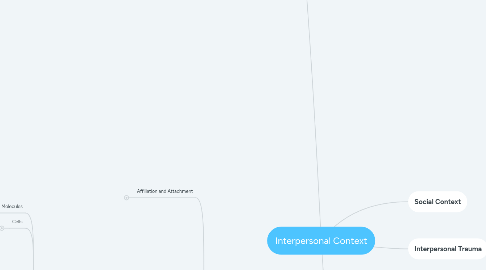
1. Social Context
2. Interpersonal Trauma
3. MAIN MAP
4. Systems for Social Processes (RDoC domain)
4.1. Affiliation and Attachment
4.1.1. Molecules
4.1.1.1. 3CRF
4.1.1.2. CRFR2
4.1.1.3. D1
4.1.1.4. Dopamine
4.1.1.5. KOR
4.1.1.6. Mu Opioid receptor
4.1.1.7. Oxytocin
4.1.1.8. Oxytocin Receptor
4.1.1.9. Vasopressin
4.1.1.10. Vasopressin 1a receptor
4.1.2. Cells
4.1.2.1. Magnocellular OT
4.1.3. Circuits
4.1.3.1. Amygdala
4.1.3.2. BNST
4.1.3.3. FF gyrus
4.1.3.4. NAcc
4.1.3.5. OFC
4.1.3.6. PVN
4.1.3.7. vmPFC
4.1.3.8. VTA-NAcc-VP-Amygdala
4.1.4. Physiology
4.1.4.1. Activation of sympathetic activity
4.1.4.2. HPA-axis activation/Down regulation
4.1.4.3. Immune Markers
4.1.4.4. Immune responses
4.1.4.5. Sex steroid changes
4.1.4.6. Vagal Tone
4.1.4.7. Vagal withdrawal
4.1.5. Behavior
4.1.5.1. Attachment Formation - Maintaining Proximity
4.1.5.2. Attachment Formation - Preference for Individual
4.1.5.3. Attachment Maintenance - Distress upon separation
4.2. Social Communication
4.2.1. Reception of Facial Communication
4.2.1.1. Molecules
4.2.1.1.1. Dopamine
4.2.1.1.2. FMRP
4.2.1.1.3. GABA
4.2.1.1.4. Oxytocin
4.2.1.1.5. Serotonin
4.2.1.1.6. Testosterone
4.2.1.1.7. Vasopressin
4.2.1.2. Cells
4.2.1.2.1. Face Selective Neurons
4.2.1.2.2. Mirror Neurons
4.2.1.3. Circuits
4.2.1.3.1. amygdala-brainstem
4.2.1.3.2. IFG-INS-amygdala/VS
4.2.1.3.3. OFC-ACC-amygdala-striatum
4.2.1.3.4. Resting State Networks
4.2.1.3.5. V1-FFA-STS-amygdala
4.2.1.3.6. V1-FFA-STS-VS
4.2.1.3.7. bilateral amygdalae and left inferior occipital cortex in ASD
4.2.1.4. Physiology
4.2.1.4.1. ECoG frontal brain asymmetry
4.2.1.4.2. Facial EMG
4.2.1.4.3. HR/BP/respiration
4.2.1.4.4. Local cerebral blood flow changes
4.2.1.4.5. N170
4.2.1.4.6. N250
4.2.1.4.7. Network Dynamics
4.2.1.4.8. Pupil Dilation
4.2.1.4.9. SCR
4.2.1.4.10. Startle reflex
4.2.1.5. Behavior
4.2.1.5.1. Eye gaze detection
4.2.1.5.2. identification of emotion
4.2.1.5.3. implicit mimicry
4.2.1.5.4. scanning patterns
4.2.2. Production of Facial Communication
4.2.2.1. Molecules
4.2.2.1.1. AP
4.2.2.1.2. Contactin
4.2.2.2. Circuits
4.2.2.2.1. Eye movements (PPC-SC-SNc-SEF-FEF-CB)
4.2.2.2.2. Facial Expression (Regions including PAG, AC)
4.2.2.3. Physiology
4.2.2.3.1. Facial EMG
4.2.2.3.2. HRV
4.2.2.3.3. NIRS
4.2.2.3.4. Photoplethysmography (skin color measure of capillary dilation; temp)
4.2.2.3.5. pupil dilation
4.2.2.3.6. SC
4.2.2.3.7. Tear Production
4.2.2.4. Behavior
4.2.2.4.1. Eye gaze aversion/contact
4.2.2.4.2. Facial Affect Production
4.2.2.4.3. Head Turning
4.2.2.4.4. Imitation of Facial gestures
4.2.2.4.5. Joint attention
4.2.2.4.6. Reciprocal emotional expression
4.2.2.4.7. Reciprocal eye contact
4.2.3. Reception of Non-Facial Communication
4.2.3.1. Molecules
4.2.3.1.1. Oxytocin
4.2.3.1.2. Vasopressin
4.2.3.2. circuits
4.2.3.2.1. A1-RSTG
4.2.3.3. (to be completed from
4.2.4. Production of Non-Facial Communication
4.2.4.1. to be completed from
4.3. Perception and Understanding of Self
4.3.1. Agency
4.3.1.1. to be completed from
4.3.2. Self-knowledge
4.3.2.1. to be completed from
4.4. Perception and Understanding of Others
4.4.1. Animacy Perception
4.4.1.1. to be completed from
4.4.2. Action Perception
4.4.2.1. to be completed from
4.4.3. Understanding Mental States
4.4.3.1. to be completed from
